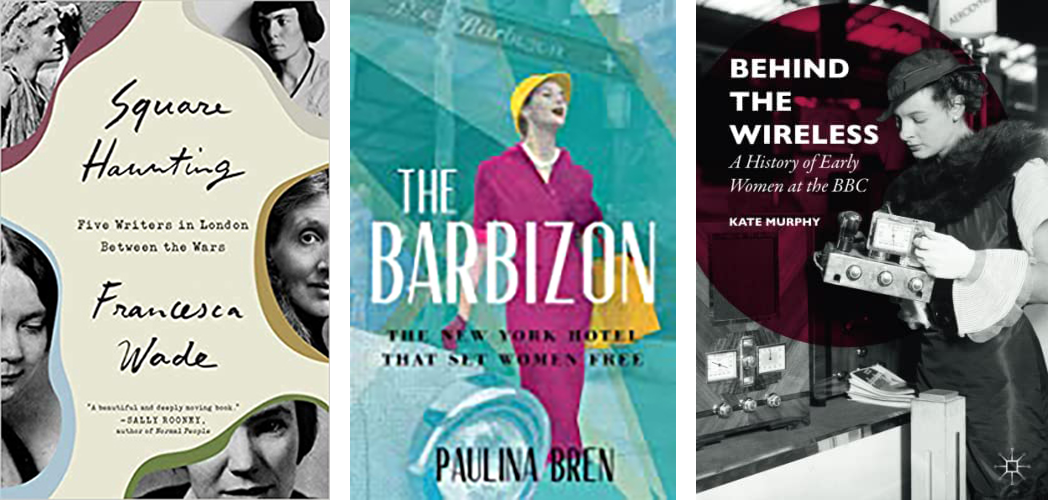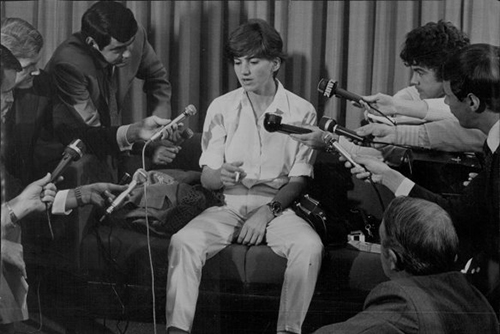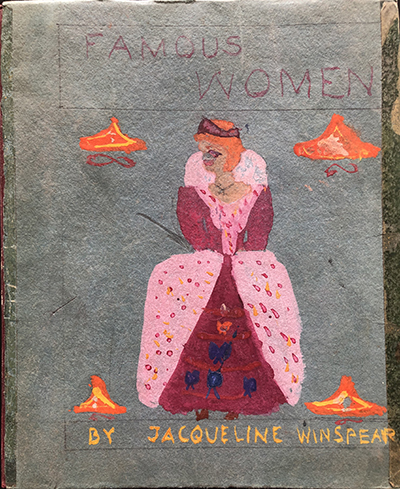You Don’t Belong Here
I’ve always liked stories with what I would call an “ensemble cast” — you know, the ones that bring together the “old gang” again or tie together a motley crew of individuals, from The Magnificent Seven to Enchanted April to Ocean’s Eight. That interest takes me right into non-fiction — I’m drawn to books that highlight the phenomenon of women who happen to have been in the same place at roughly the same time and who may or may not have known one another, yet in their way were part of an extraordinary cadre of achievers. I loved Square Haunting: Five Writers in London Between The Wars by Francesca Wade, about women who lived in Mecklenburg Square during that extraordinary time, and The Barbizon: The Hotel That Set Women Free by Paulina Bren, with stories about the women who resided in the residential hotel, newcomers to New York city hoping to blaze a trail. Virginia Woolf lived in Mecklenburg Square and Joan Didion at the Barbizon — which made me wish I could have been in either of those places at the time, though we would in all likelihood have just run past one another on route to wherever we were headed. I’m currently reading Kate Murphy’s Behind The Wireless, about the women who worked for the BBC in the early days.

Needless to say, a couple of years ago, when I was asked by The Washington Post to review You Don’t Belong Here by Elizabeth Becker, about three women war correspondents in Vietnam, I jumped at the chance.
I came across the book again this weekend when I was going through my personal library — it was well past time for a bit of a “clear out” of books I would never read again or would not need for research. Becker’s book was filled with yellow notes sticking out of almost every other page because there was so much I wanted to say about it in my review, but of course I was limited on words. I thought it was a terrific book — it has since won a raft of awards — so I decided it was worthy of my attention all over again, which is why I’m writing about it here in my WOMENSONG blog. Oh, and it wasn’t packed into the donation box — it’s staying on the shelf!
Along with writing about three women war correspondents whose paths she crossed while reporting from Vietnam, Becker told her own story, which starts with a “nightmare” of a reason to relinquish her graduate studies — a professor who “kneecapped” her future when she wouldn’t sleep with him. In short order Becker filed a complaint, threw in the towel on her studies, and bought a one-way ticket to Cambodia. It was 1973, and 25-year-old Becker was off to be a war correspondent. I should add that the angry grad student went on to become a highly respected journalist with an array of awards to her name. In 2015, based on her reporting from Cambodia for The Washington Post and her subsequent book, When the War Was Over, Becker was called as an expert witness at the Khmer Rouge genocide tribunal in Phnom Penh. It was during those hearings that Becker realized, “No one knew what it had meant to be a woman covering the Vietnam War.” In writing You Don’t Belong Here: How Three Women Rewrote the Story of War, Becker not only shone a light on the contributions of those women correspondents — Kate Webb, Frances “Frankie” FitzGerald, and Catherine Leroy, along with the risks they took to show and tell the raw truths of the war as they saw it — but gave this reader a valuable depth of cultural and historical insight into the conflict.

Elizabeth Becker in Vietnam
Becker met Australian journalist Kate Webb during a layover in Hong Kong on that fateful journey to Cambodia. Webb was already a reporting legend, owing both to her work and to her kidnapping by the North Vietnamese. She, too, had left home clutching a one-way ticket to war. Twenty-six-year-old American Frances “Frankie” FitzGerald had done the same in 1966, as had French photojournalist Catherine Leroy, who was 21 when she landed in Vietnam with her Leica M2 camera. Arriving in a war zone, not one of those women imagined the impact their work would have — and not just because of their gender in what was considered a man’s world.

Kate Webb
FitzGerald was the daughter of Desmond FitzGerald, who became deputy director of the CIA, and Marietta Peabody, a socialite who represented the United States on the United Nations Commission on Human Rights during the Kennedy administration. Following the couple’s divorce, Peabody had affairs with John Huston and Adlai Stevenson. Though Frankie FitzGerald was well connected, it was a thorn in her side that other correspondents assumed those connections helped her up the ladder to publication. She landed hard in Saigon. She had been writing “personality pieces” — the usual fare assigned to women in the newspaper business — when she left for Southeast Asia. Becker writes, “Vietnam hit FitzGerald like a thunderbolt,” adding that on the way from the airport, she “inhaled dust and fumes from decrepit buses and military jeeps and was jarred by the sight of the once beautiful city — the Paris of the East — defiled by the demands of war.”

Frances FitzGerald
FitzGerald was serious about reporting the “truth of war” without necessarily supporting the American position. She wrote her first article on spec for the Village Voice, positioning herself as “someone who asked different questions and admitted when she didn’t have the answers.” That mindset underpinned her work, and Becker describes a maturing war correspondent, one not afraid to dig deep. FitzGerald’s final report before leaving Vietnam was titled Behind the Facade: The Tragedy of Saigon — it predicted the outcome of America’s failure.
FitzGerald’s relationship with veteran reporter Ward Just meant she avoided the sexual advances and innuendo that trailed Leroy. The diminutive photographer — she was five feet tall and weighed 87 pounds — brought certain advantages to her work. She was an experienced parachutist, and given her stature, she could weave her way into places others couldn’t. And she was brave beyond measure.

Catherine Leroy — she had already done about 84 parachute jumps before she went to Vietnam.
It was a series of photographs taken in the midst of combat that sealed Leroy’s reputation. Becker writes that “intimate portraits during battle became Leroy’s hallmark” and describes the way Leroy would crawl in the mud alongside the soldiers, focusing on their eyes and changes in expression. In Khe Sanh to report on the Hill Fights, she was following the company when the Vietnamese opened fire at the summit. A 20-year-old medic, Vernon Wike, ran toward a fallen Marine, took off his helmet and leaned forward, listening for a heartbeat. The look of anguish on his face is searing — and Leroy kept clicking as Wike came to his feet and charged the bunker, the dead man’s M16 in his hands.

One of Leroys’ photographs that stayed with me — these soldiers don’t look old enough to graduate high school
Becker’s nuanced storytelling follows Leroy’s career with respectful sensitivity, and quotes Leroy: “Those images rest inside of you with the violence, madness and fear and agony.”
According to Becker, Kate Webb developed “a loner’s mystique within the press corps.” Given Becker’s descriptions of the way female war correspondents were often undermined as conflict groupies or incompetent hangers-on, it was probably a wise move, especially since her work was gaining the kind of attention that male correspondents considered their exclusive domain. Webb spent time immersing herself in the local culture to go beyond “that impersonal language of an Army war report.” Becker’s account of the circumstances surrounding Webb’s kidnapping and eventual release reads like a thriller — the sick and skeletal reporter emerging from the jungle only to become the story.

Kate Webb the reporter becomes the story
The fourth woman who rewrote the story of war was, of course, Elizabeth Becker, who with an abundance of grace gives fresh insight into the background and achievements of three extraordinary war correspondents. Yet there is a certain undercurrent, another crucial layer emerging as the narrative progresses, and that is the parallel story of American political naivete in committing a military with a World War II mindset to a war against a people whose history and culture — and ways of fighting — they made little attempt to comprehend. Webb, FitzGerald, Leroy and Becker quickly shed any naivete they might have had as they reported on the war and chronicled the desperate human cost of American hubris.

Another of Catherine Leroy’s photographs
In recent years a number of memoirs and biographies have been published focusing on female war correspondents (I’ve probably read every one). It’s a compelling narrative: Young woman dons khaki and takes notebook into the terror of war. But perhaps what attracts us is a more fundamental passage, one reflected in myths and legends — you could call it “The Heroine’s Journey” — the woman who heeds the call to adventure, who meets challenges and temptations along the way, and who is transformed by the experience. You Don’t Belong Here is the story of three women who answered the archetypal call to adventure — and found themselves immersed in the chaos that was the Vietnam War.
Note: Part of the above was taken from my original review for The Washington Post.
In addition, readers may be interested in an article on women war correspondents from the past and present (I could have written so much more, but again, word limits prevented me from doing so!), published in Lithub.


